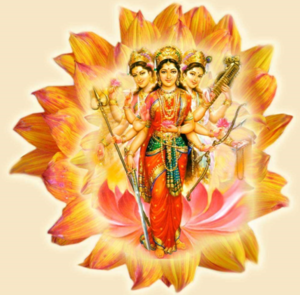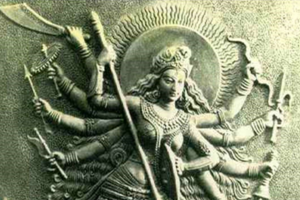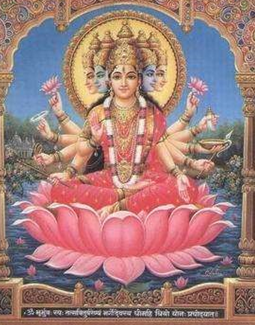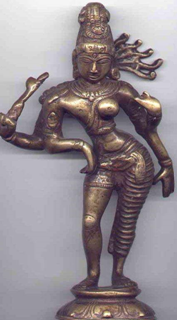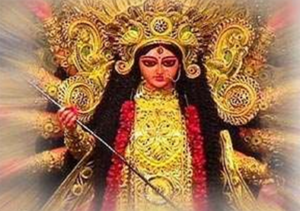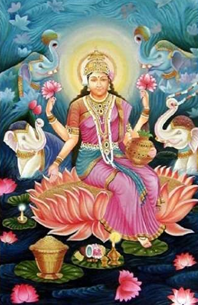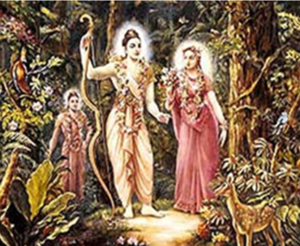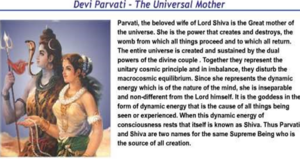Talk:The Gender of Īshvara: Devī or Īshvarī
By Sri Vishal Agarwal
Swami Bhāskarananda observes that Īśvara has no gender, yet devotees may relate to the Divine through a variety of human relationships:
- “Īśvara has no gender. Yet the people can look upon Īśvara as both father and mother. According to the devotees’ mental attitudes they can establish other relationships with Īśvara as well. They can look upon Īśvara as friend, child, or even husband or sweetheart… Many saints of Hindu dharm like Kamalākānta, Rāmaprasāda, and Śrī Rāmakṛṣṇa looked upon Bhagavān as the Divine Mother. Such relationships were purely mental and devoid of physical association. According to Śrī Rāmakṛṣṇa, such attitudes hasten realization by fostering closeness between Bhagavān and the devotee.”[1]
In Hindu dharm, brahman is also worshipped in its saguṇa form as devī or the Divine Mother. Feminine theology is expressed at two levels:
- As the Universal Mother, creator and ruler of all male deva-s.
- As consort of male forms of Bhagavān, such as Lakṣmī with Viṣṇu or Pārvatī with Śiva.
Ṛṣi Parāśara highlighted the inseparability of Viṣṇu and Lakṣmī in the Viṣṇu Purāṇa:
- “Always a companion of Viṣṇu and the Mother of this Universe, Devī Lakṣmī is eternal. Viṣṇu is omnipresent, so is She. If She is speech, Viṣṇu is the object of description. Viṣṇu is the law, and She is the policy. Bhagavān Viṣṇu is knowledge, She is intelligence. He is dharm, She is good karman. If Viṣṇu is the creator, She is the creation that abides eternally with Him…”
Viṣṇu Purāṇa 1.8.17–20ab
The Śākta tradition regards devī as the Supreme manifestation of saguṇa brahman, the sovereign ruler of all deities. The Devī Bhāgavata Purāṇa extols her maternal role:
- “At every step, men commit mistakes. And yet, in this universe, who else but one’s mother forgives and forbears our repeated mistakes? Therefore, without delay, one should worship and seek refuge with the Divine Mother with singular devotion. She alone can make all our efforts bear fruit.”
Devī Bhāgavata Purāṇa 7.31.18–19
Even in philosophical schools emphasizing nirguṇa brahman, the feminine is often understood as prakṛti consisting of the three guṇa-s, with the cosmos arising from the interplay of brahman and prakṛti.
Sanskrit, the language of revelation, has neuter, masculine, and feminine genders. The word brahman is neuter, and the famous Ṛgvedic phrase “Ekam sat” (Truth is one) also uses a neuter form, underscoring that the Supreme transcends male and female categories.[2]
Both male and female deities are praised in the veda-s. Female deities such as Uṣas and Sarasvatī are invoked with epithets of brilliance, wisdom, and auspiciousness. The Atharvaveda begins with an invocation to a devī dwelling in waters who fulfills human desires.[3] The Gāyatrī Mantra, regarded as the holiest prayer, is symbolically represented as a five-headed goddess and called the “Mother of the Vedas.”[4]
The Vedic corpus also employs feminine imagery for the Divine. The Ṛgveda (1.73.3) likens the Divine to a beloved wife adored by her husband, and vāk (sacred speech) is feminine, described as a beautiful maiden manifesting to her lover (10.71.4).
Goddesses are often portrayed as mothers of the most powerful male deities. Devī Aditi is invoked as the mother of Varuṇa, Mitra, Aryaman, Rudras, Indra, and kings, addressed as mistress of cosmic order, omnipotent, youthful, and a wise guide.[5]
The veda-s rarely portray male deva-s without female counterparts. Ritual invocations almost always summon deva-s together with devī-s, reflecting the complementarity of masculine and feminine divine principles.
Around 2000 years ago, Hindu dharm crystallized into five major traditions of worship: Saura, Gāṇapatya, Vaiṣṇava, Śaiva, and Śākta. Today, the majority belong to the last three.
The Śākta tradition emphasizes the Mother of the Universe,[6] venerated as Śakti, Umā, Maheśvarī and many other names. Its extensive textual corpus (tantra-s) is authoritative even outside the sect.
The Śaiva tradition is often described as a male counterpart to the Śākta, and the two share liturgies and texts. Iconography of Ardhanārīśvara depicts the Divine as half-male, half-female, affirming that the Supreme is either beyond gender or embodies both simultaneously.
Even Vaiṣṇava traditions sometimes describe Viṣṇu incarnating in female form, while the Devī is portrayed as embodying the combined powers of Brahmā, Viṣṇu, and Śiva.
Across sects, the feminine principle remains central. Festivals such as Navarātri and Durgā Pūjā celebrate the Divine Mother as the supreme source of power, wisdom, and compassion.
In the Vaiṣṇava tradition, Bhagavān is worshipped with Śrī (Lakṣmī) as his eternal consort.[7] Their incarnations, such as Rāma with Sītā or Kṛṣṇa with Rādhā or Rukmiṇī, are revered as divine couples. In some Vaiṣṇava sects, Rādhā is even accorded greater theological significance than Kṛṣṇa himself. Independent texts such as the Sītopaniṣad and Rādhopaniṣad testify to the centrality of the feminine in Vaiṣṇava devotion.
Notably, when invoking the Divine Couple, the feminine name often precedes the masculine: “Sītā–Rām,” “Rādhe–Śyām,” “Umā–Maheś,” or “Śrī Viṣṇu.” Popular non-sectarian prayers also emphasize this ordering, as in the well-known verse: “tvameva mātā ca pitā tvameva” (“You alone are Mother, and You alone are Father”).
In the Gāṇapatya tradition, the central focus is Gaṇeśa, the elephant-headed deity. While the sect has fewer adherents compared to Vaiṣṇava, Śaiva, or Śākta traditions, Gaṇeśa is universally invoked at the beginning of rituals across sectarian lines. Mythological accounts frequently highlight his association with his mother Pārvatī; some traditions narrate that she created him independently of Śiva. Gaṇeśa is primarily worshipped in his child form, often alongside his brother Skanda and their mother.
Thus, the feminine aspect of the Divine remains integral across traditions. Festivals centered on the Goddess dominate the religious calendar in different regions: Durgā Pūjā in eastern India, Navarātri in Gujarat, and Dīpāvalī in northern India and among diaspora communities—where the worship of Devī Lakṣmī (Lakṣmī Pūjan) takes precedence.
References[edit]
- ↑ Swami Bhaskarananda. Essentials of Hinduism. Seattle (US): Viveka Press, 2002, pp. 71–72.
- ↑ The word brahman is neuter in gender. Likewise, satyam (truth) and ṛtam (cosmic order) are neuter in Sanskrit.
- ↑ Atharvaveda, Śaunaka Saṃhitā 1.6.1.
- ↑ Śaunakīya Atharvaveda 19.71.1.
- ↑ Shaunakīya Atharvaveda 7.6.2; Mādhyandina Yajurveda 21.5.
- ↑ Mārkaṇḍeya Purāṇa 91.2.
- ↑ Viṣṇu Purāṇa 1.9.142–146.

